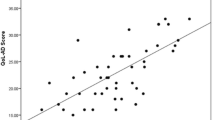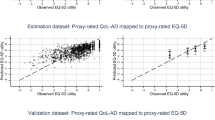Abstract
Objective
This paper reports on the valuation of quality-of-life states in the Alzheimer’s Disease Five Dimensions (AD-5D) instrument in a representative sample of the general population in Australia using the discrete-choice experiment with duration (DCETTO) elicitation technique.
Method
A DCE with 200 choice sets of two quality-of-life (QoL) state–duration combinations blocked into 20 survey versions, with ten choice sets in each version, was designed and administered online to a sample representative of the Australian population. Two additional choice sets comprising internal consistency and dominance checks were included in each survey version. A range of model specifications investigating preferences with respect to duration and interactions between AD-5D dimension levels were estimated. Utility weights were developed, with estimated coefficients transformed to the 0 (being dead) to 1 (full health) scale, suitable for the calculation of quality-adjusted life-year (QALY) weights for use in economic evaluation.
Results
In total, 1999 respondents completed the choice experiment. Overall, respondents were slightly better educated and had higher annual incomes than the Australian general population. The estimation results from different specifications and models were broadly consistent with the monotonic nature of the AD-5D: utility increased with increased life expectancy and decreased as the severity level for each dimension worsened. A utility value set was generated for the calculation of utilities for all QoL states defined by the AD-5D descriptive system.
Conclusion
The DCE-based utility value set is now available to use to generate QALYs for the economic evaluation of treatments and interventions targeting people with dementia and/or their family caregivers.


Similar content being viewed by others
Data Availability
The dataset used to generate the algorithm is available for reuse with commercial restriction in The University of Queensland eSpace repository [55].
References
Prince M, Ali G-C, Guerchet M, Prina AM, Albanese E, Wu Y-T. Recent global trends in the prevalence and incidence of dementia, and survival with dementia. Alzheimers Res Ther. 2016;8:23. https://doi.org/10.1186/s13195-016-0188-8.
Dankó D. Health technology assessment in middle-income countries: recommendations for a balanced assessment system. J Mark Access Health Policy. 2014;2(1):23181. https://doi.org/10.3402/jmahp.v2.23181.
Corbacho B, Pinto-Prades JL. Health economic decision-making: a comparison between UK and Spain. Br Med Bull. 2012;103(1):5–20. https://doi.org/10.1093/bmb/lds017.
Drummond M, et al. Transferability of economic evaluations across jurisdictions: ISPOR good research practices task force report. Value Health. 2009;12(4):409–18. https://doi.org/10.1111/j.1524-4733.2008.00489.x.
Guidelines for the economic evaluation of health technologies: Canada, 4th edn. Ottawa: CADTH, 2017.
Versteegh M, Knies S, Brouwer W. From good to better: new Dutch Guidelines For Economic Evaluations in healthcare. PharmacoEconomics. 2016;34(11):1071–4. https://doi.org/10.1007/s40273-016-0431-y.
Janssen MF, Bonsel GJ, Luo N. Is EQ-5D-5L better than EQ-5D-3L? A head-to-head comparison of descriptive systems and value sets from seven countries. PharmacoEconomics. 2018;36(6):675–97. https://doi.org/10.1007/s40273-018-0623-8.
Brazier J, Roberts J, Deverill M. The estimation of a preference-based measure of health from the SF-36. J Health Econ. 2002;21(2):271–92. https://doi.org/10.1016/S0167-6296(01)00130-8.
Torrance GW, Feeny DH, Furlong WJ, Barr RD, Zhang Y, Wang Q. Multiattribute utility function for a comprehensive health status classification system: health utilities index mark 2. Med Care. 1996;34(7):702–22.
Torrance GW, Furlong W, Feeny D, Boyle M. Multi-attribute preference functions. PharmacoEconomics. 1995;7(6):503–20. https://doi.org/10.2165/00019053-199507060-00005.
Horsman J, Furlong W, Feeny D, Torrance G. The Health Utilities Index (HUI®): concepts, measurement properties and applications. Health Qual Life Outcomes. 2003;1(1):54. https://doi.org/10.1186/1477-7525-1-54.
Feeny D, et al. Multiattribute and single-attribute utility functions for the health utilities index mark 3 system. Med Care. 2002;40(2):113–28.
Li L, Nguyen K-H, Comans T, Scuffham P. Utility-based instruments for people with dementia: a systematic review and meta-regression analysis. Value Health. 2018. https://doi.org/10.1016/j.jval.2017.09.005.
Ettema TP, Dröes R-M, de Lange J, Ooms ME, Mellenbergh GJ, Ribbe MW. The concept of quality of life in dementia in the different stages of the disease. Int Psychogeriatr. 2005;17(3):353–70. https://doi.org/10.1017/S1041610205002073.
Brod M, Stewart AL, Sands L, Walton P. Conceptualization and measurement of quality of life in dementia: the Dementia quality of life instrument (DQoL). Gerontologist. 1999;39(1):25–36. https://doi.org/10.1093/geront/39.1.25.
Selai CE, Trimble MR, Rossor MN, Harvey RJ. Assessing quality of life in dementia: preliminary psychometric testing of the quality of life assessment schedule (QOLAS). Neuropsychol Rehabil. 2001;11(3–4):219–43. https://doi.org/10.1080/09602010042000033.
Lawton MP. Quality of life in alzheimer disease. Alzheimer Dis Assoc Disord. 1994;8:138–50.
Keating N, Gaudet N. Quality of life of persons with dementia. J Nutr Health Aging. 2012;16(5):454–6. https://doi.org/10.1007/s12603-011-0346-4.
Missotten P, Dupuis G, Adam S. Dementia-specific quality of life instruments: a conceptual analysis. Int Psychogeriatr Camb. 28(8):1245–1262. 2016. https://www.ezproxy.library.uq.edu.au/10.1017/S1041610216000417
Logsdon RG, Gibbons L, McCurry S, Teri L. Quality of life in alzheimer’s disease: patient and caregiver reports. J Ment Health Aging. 1999;5(1):21–322.
Logsdon R, Gibbons L, McCurry S, Teri L. Assessing quality of life in older adults with cognitive impairment. Psychosom Med. 2002;64:510–9.
Smith S, et al. Measurement of health-related quality of life for people with dementia: development of a new instrument (DEMQOL) and an evaluation of current methodology. Health Technol Assess. 2005. https://doi.org/10.3310/hta9100.
Smith SC, et al. Development of a new measure of health-related quality of life for people with dementia: DEMQOL. Psychol Med. 2007;37(5):737–46. https://doi.org/10.1017/S0033291706009469.
Terada S, et al. Development and evaluation of a health-related quality of life questionnaire for the elderly with dementia in Japan. Int J Geriatr Psychiatry. 2002;17(9):851–8. https://doi.org/10.1002/gps.711.
Arons AMM, Schölzel-Dorenbos CJM, Olde Rikkert MGM, Krabbe PFM. A simple and practical index to measure dementia-related quality of life. Value Health. 2016;19(1):60–5. https://doi.org/10.1016/j.jval.2015.07.011.
Mulhern B, et al. Development of DEMQOL-U and DEMQOL-PROXY-U: generation of preference-based indices from DEMQOL and DEMQOL-PROXY for use in economic evaluation. Health Technol Assess. 2013;17(5):1–140. https://doi.org/10.3310/hta17050.
Yang F, Dawes P, Leroi I, Gannon B. Measurement tools of resource use and quality of life in clinical trials for dementia or cognitive impairment interventions: a systematically conducted narrative review. Int J Geriatr Psychiatry. 2018;33(2):e166–e176176. https://doi.org/10.1002/gps.4771.
Riepe MW, et al. Quality of Life as an outcome in Alzheimer’s disease and other dementias—obstacles and goals. BMC Neurol. 2009;9:47. https://doi.org/10.1186/1471-2377-9-47.
Bowling A, et al. Quality of life in dementia: a systematically conducted narrative review of dementia-specific measurement scales. Aging Ment Health. 2014;19(1):13–311. https://doi.org/10.1080/13607863.2014.915923.
Smith SC, et al. What constitutes health-related quality of life in dementia? Development of a conceptual framework for people with dementia and their carers. Int J Geriatr Psychiatry. 2005;20(9):889–95. https://doi.org/10.1002/gps.1374.
Edelman P, Fulton BR, Kuhn D, Chang C-H. A Comparison of three methods of measuring dementia-specific quality of life: perspectives of residents, staff, and observers. Gerontologist. 2005;45(Suppl_1):27–36. https://doi.org/10.1093/geront/45.suppl_1.27.
Comans TA, et al. Developing a dementia-specific preference-based quality of life measure (AD-5D) in Australia: a valuation study protocol. BMJ Open. 2018;8(1):e018996. https://doi.org/10.1136/bmjopen-2017-018996.
Nguyen K-H, Mulhern B, Kularatna S, Byrnes J, Moyle W, Comans T. Developing a dementia-specific health state classification system for a new preference-based instrument AD-5D. Health Qual Life Outcomes. 2017;15(1):21. https://doi.org/10.1186/s12955-017-0585-0.
Mulhern B, Norman R, Street DJ, Viney R. One method, many methodological choices: a structured review of discrete-choice experiments for health state valuation. PharmacoEconomics. 2019;37(1):29–43. https://doi.org/10.1007/s40273-018-0714-6.
Soekhai V, de Bekker-Grob EW, Ellis AR, Vass CM. Discrete choice experiments in health economics: past, present and future. PharmacoEconomics. 2019;37(2):201–26. https://doi.org/10.1007/s40273-018-0734-2.
McFadden D. Conditional logit analysis of qualitative choice behaviour. 1973.
Horowitz JL, et al. Advances in random utility models report of the workshop on advances in random utility models duke invitational symposium on choice modeling behavior. Mark Lett. 1994;5(4):13.
Bansback N, Brazier J, Tsuchiya A, Anis A. Using a discrete choice experiment to estimate health state utility values. J Health Econ. 2012;31(1):306–18. https://doi.org/10.1016/j.jhealeco.2011.11.004.
Rowen D, et al. ‘Estimating a preference-based single index measuring the quality-of-life impact of self-management for diabetes. Med Decis Making. 2018. https://doi.org/10.1177/0272989X18784291.
Rowen D, Mulhern B, Stevens K, Vermaire JH. Estimating a Dutch Value Set for the pediatric preference-based CHU9D using a discrete choice experiment with duration. Value Health. 2018;21(10):1234–42. https://doi.org/10.1016/j.jval.2018.03.016.
Rowen D, Brazier J, Tsuchiya A, Young T, Ibbotson R. It’s all in the name, or is it? The impact of labeling on health state values. Med Decis Making. 2012;32(1):31–40. https://doi.org/10.1177/0272989X11408435.
Choice Metrics, ‘Ngene 1.1. 2’, User Man. Ref. Guide, 2014.
Netten A, et al. Outcomes of social care for adults: developing a preference-weighted measure. Health Technol Assess Winch Engl. 2012;16(16):1–166. https://doi.org/10.3310/hta16160.
Fiebig DG, Keane MP, Louviere J, Wasi N. The generalized multinomial logit model: accounting for scale and coefficient heterogeneity. Mark Sci. 2010;29(3):393–421. https://doi.org/10.1287/mksc.1090.0508.
Feng Y, Devlin NJ, Shah KK, Mulhern B, van Hout B. New methods for modelling EQ-5D-5L value sets: an application to English data. Health Econ. 2018;27(1):23–38. https://doi.org/10.1002/hec.3560.
Hauber AB, et al. Statistical methods for the analysis of discrete choice experiments: a report of the ISPOR conjoint analysis good research practices task force. Value Health. 2016;19(4):300–15. https://doi.org/10.1016/j.jval.2016.04.004.
Lancsar E, Fiebig DG, Hole AR. Discrete choice experiments: a guide to model specification, estimation and software. PharmacoEconomics. 2017. https://doi.org/10.1007/s40273-017-0506-4.
Johnson FR, et al. Constructing experimental designs for discrete-choice experiments: report of the ISPOR conjoint analysis experimental design good research practices task force. Value Health. 2013;16(1):3–13. https://doi.org/10.1016/j.jval.2012.08.2223.
Australian Bureau of Statistics. Census of population and housing: census dictionary. Canberra: ABS; 2016.
Welch A, et al. Confirmatory analysis of a health state classification system for people living with dementia: a qualitative approach. J Health Serv Res Policy. 2019. https://doi.org/10.1177/1355819619850599.
Silberfeld M, Rueda S, Krahn M, Naglie G. Content validity for dementia of three generic preference based health related quality of life instruments. Qual Life Res. 2002;11(1):71–9. https://doi.org/10.1023/A:1014406429385.
Boyle KJ, Morrison M, MacDonald DH, Duncan R, Rose J. Investigating internet and mail implementation of stated-preference surveys while controlling for differences in sample frames. Environ Resour Econ. 2016;64(3):401–19. https://doi.org/10.1007/s10640-015-9876-2.
Yeager DS, et al. Comparing the accuracy of RDD telephone surveys and internet surveys conducted with probability and non-probability samples. Public Opin Q. 2011;75(4):709–47. https://doi.org/10.1093/poq/nfr020.
Rabin R, de Charro F. EQ-5D: a measure of health status from the EuroQol Group. Ann Med. 2001;33(5):337–43. https://doi.org/10.3109/07853890109002087.
Comans T, Nguyen K-H, Welch A. AD-5D algorithm generation dataset. UQ eSpace, Apr. 03, 2020. https://espace.library.uq.edu.au/view/UQ:a11d417.
Acknowledgements
The authors would like to acknowledge the contributions of the AD5D project team, the project manager Alyssa Welch and participants of the online survey.
Author information
Authors and Affiliations
Contributions
TC conceived the study, all authors contributed to the overall study design. KHN and BM designed the DCE, KHN analysed the data, and all authors made the decisions on direction of data analysis and final models to use. The first draft manuscript was written by KHN and TC; all authors contributed to writing and editing draft manuscripts and approved the final version.
Corresponding author
Ethics declarations
Funding
This study was supported by funding provided by the National Health and Medical Research Council (NHMRC) Partnership Centre on Dealing with Cognitive and Related Functional Decline in Older People (Grant no. GNT9100000). A/Prof Tracy Comans is supported by an NHMRC Boosting Dementia Research Fellowship. The contents of the published materials are solely the responsibility of the University of Queensland and the individual authors identified and do not reflect the views of the NHMRC or any other funding bodies or the funding partners.
Conflict of interest
Tracy Comans, Kim-Huong Nguyen, and Julie Ratcliffe have no conflicts of interest relevant to this manuscript. Brendan Mulhern and Donna Rowen were involved in the development of the DEMQOL-U, a utility instrument for dementia.
Ethical approval
Ethical approval for this study was granted from Griffith University Human Research and Ethics Committee (approval number 2016/626) and University of Queensland Human Research and Ethics Committee (approval number 2017001481).
Electronic supplementary material
Below is the link to the electronic supplementary material.
Rights and permissions
About this article
Cite this article
Comans, T.A., Nguyen, KH., Ratcliffe, J. et al. Valuing the AD-5D Dementia Utility Instrument: An Estimation of a General Population Tariff. PharmacoEconomics 38, 871–881 (2020). https://doi.org/10.1007/s40273-020-00913-7
Published:
Issue Date:
DOI: https://doi.org/10.1007/s40273-020-00913-7




